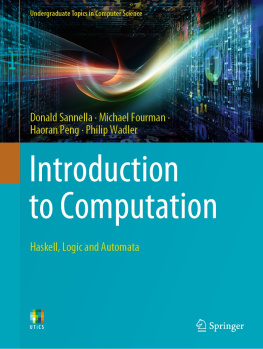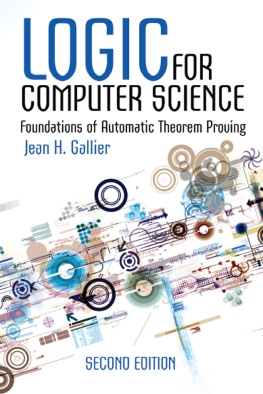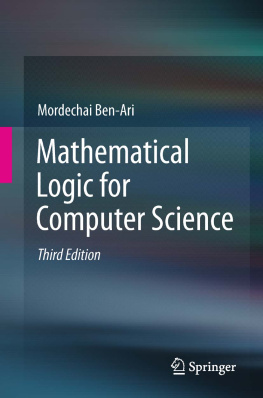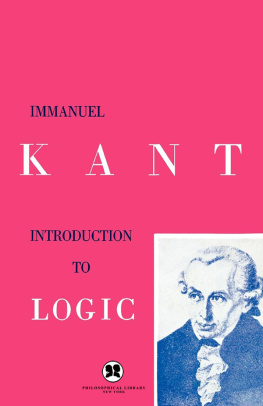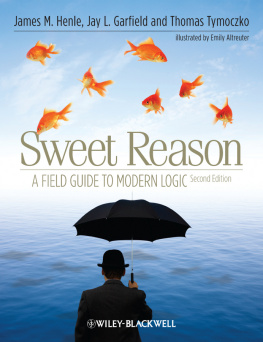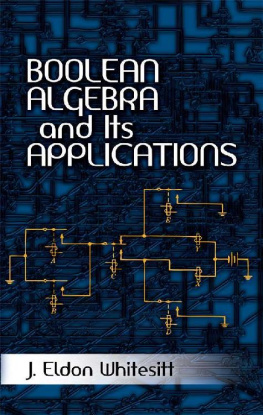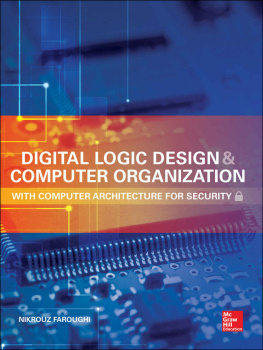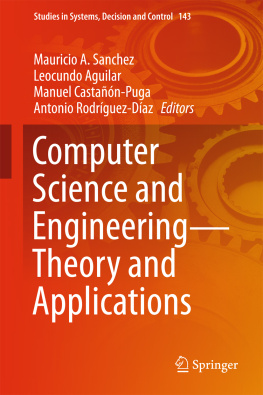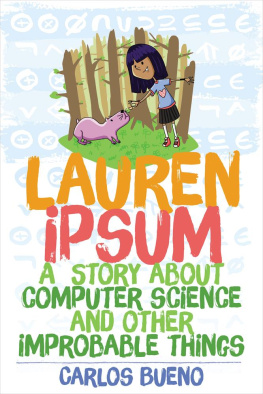Rex Page - Essential Logic for Computer Science
Here you can read online Rex Page - Essential Logic for Computer Science full text of the book (entire story) in english for free. Download pdf and epub, get meaning, cover and reviews about this ebook. publisher: MIT Press, genre: Home and family. Description of the work, (preface) as well as reviews are available. Best literature library LitArk.com created for fans of good reading and offers a wide selection of genres:
Romance novel
Science fiction
Adventure
Detective
Science
History
Home and family
Prose
Art
Politics
Computer
Non-fiction
Religion
Business
Children
Humor
Choose a favorite category and find really read worthwhile books. Enjoy immersion in the world of imagination, feel the emotions of the characters or learn something new for yourself, make an fascinating discovery.

- Book:Essential Logic for Computer Science
- Author:
- Publisher:MIT Press
- Genre:
- Rating:4 / 5
- Favourites:Add to favourites
- Your mark:
- 80
- 1
- 2
- 3
- 4
- 5
Essential Logic for Computer Science: summary, description and annotation
We offer to read an annotation, description, summary or preface (depends on what the author of the book "Essential Logic for Computer Science" wrote himself). If you haven't found the necessary information about the book — write in the comments, we will try to find it.
Essential Logic for Computer Science — read online for free the complete book (whole text) full work
Below is the text of the book, divided by pages. System saving the place of the last page read, allows you to conveniently read the book "Essential Logic for Computer Science" online for free, without having to search again every time where you left off. Put a bookmark, and you can go to the page where you finished reading at any time.
Font size:
Interval:
Bookmark:
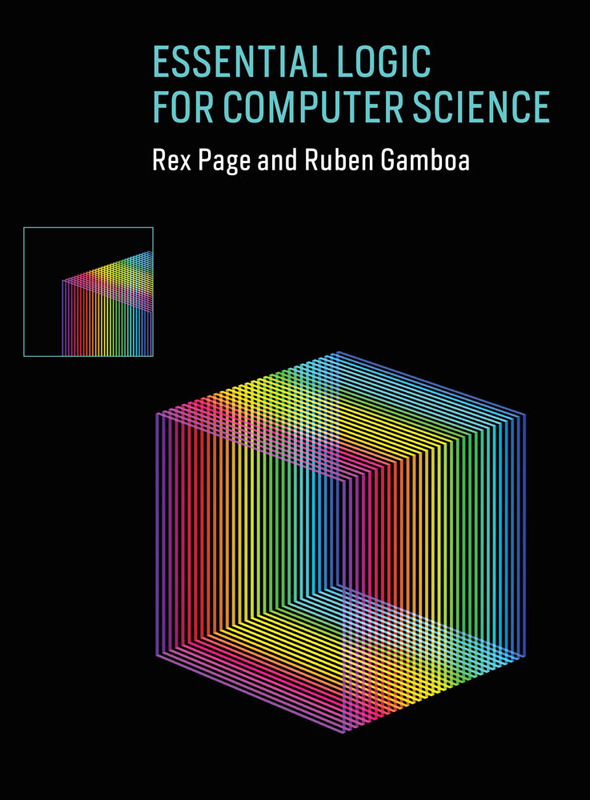
Essential Logic for Computer Science
Rex Page and Ruben Gamboa
The MIT Press
Cambridge, Massachusetts
London, England
2018 Massachusetts Institute of Technology
All rights reserved. No part of this book may be reproduced in any form by any electronic or mechanical means (including photocopying, recording, or information storage and retrieval) without permission in writing from the publisher.
This book was set in LaTeX by the authors. Printed and bound in the United States of America.
Library of Congress Cataloging-in-Publication Data
Names: Page, Rex L., author. | Gamboa, Ruben, author.
Title: Essential logic for computer science / Rex Page and Ruben Gamboa.
Description: Cambridge, MA; London, England: The MIT Press, [2018] | Includes bibliographical
references and index.
Identifiers: LCCN 2018016822 | ISBN 9780262039185 (hardcover: alk. paper)
Subjects: LCSH: Computer logic.
Classification: LCC QA76.9.L63 P34 2018 | DDC 005.101/5113dc23 LC record available at https://lccn.loc.gov/2018016822
d_r0
To Lucy Saarni, artist and philosopher
Rex
and
To Mona Gamboa and the kids, who enrich life and laugh, sometimes, at logic jokes
Ruben
List of Figures
Equations of numeric algebra.
Why (1) (1) = 1.
Boolean axioms (basic equations).
Proof of theorem { truth table}.
Proof of theorem { complement}.
Proof of theorem { truth table}.
Proof of theorem { truth table}.
Proof of theorem { null}.
Proof of theorem { absorption}.
Rules of grammar for Boolean formulas.
Axioms of Boolean algebra.
Some Boolean theorems.
Digital circuits = logic formulas.
Nand is all you need.
Rules of inference for natural deduction.
Theorem {Socrates was mortal}: citing modus ponens.
{ commutes}: citing three inference rules involving .
{self-implication}: citing {identity} and { introduction} inference rules.
{ commutes}: citing { elimination}.
Proving the implication chain rule.
{modus tollens}: citing a theorem to justify an inference.
{ forward}: citing reductio ad absurdum.
{disjunctive syllogism}: citing {contradiction}.
A four-step strategy for reasoning with quantifiers.
Equations of quantifier reasoning.
Proof of equation { }.
Example: migrating quantifiers.
A game of Nim.
Shorthand for nested cons: list.
Nonempty list predicate: consp.
Numbered list notation.
List constructor and deconstructors: cons, first, rest.
Length of list: .
Formula selector: .
DoubleCheck test of append.
List concatenation: append.
Mathematical induction: a rule of inference.
The three Cs: a guide to inductive definitions.
Defining concatenation: append.
Defining list suffix extractor: nthcdr.
Inductive case: S(n) S(n + 1).
Defining list prefix extractor: prefix.
Inductive case: n. P(n) P(n + 1).
Proof Pad session with proof bar.
Importing theorems to facilitate proof: append-suffix theorem.
Theorem with constraint: append-prefix.
Fibonacci numbers.
Fibonacci numbers: quick delivery.
Fast Fibonacci delivers Fibonacci numbers.
Theorem {halting problem}: a proof by contradiction.
Definitions of operators and loop.
Proof of theorem {H}.
Theorem {halting problem}: a proof by contradiction.
{Horner 10}: proof of base case.
{Horner 10}: proof of inductive case.
Proof by induction of theorem {dgts-ok}.
Mathematical induction (strong induction version).
Definitions of operators bits and numb.
Adding decimal numerals.
Adding binary numerals.
Half-adder circuit and ACL2 model.
Full-adder circuit and ACL2 model.
Full-adder theorem.
Two-bit adder and ACL2 model.
Ripple-carry adder and ACL2 model.
Adding w-bit binary numerals.
Theorem {adder-ok}: proof by mathematical induction.
Twos-complement numerals for three-bit words.
Twos-complement negation trick.
Bignum addition operator.
Grade-school multiplication: digit by digit.
Bignum multiplication operator.
Theorem {mux-length}: inductive case when both operands are nonempty.
Theorems and lemmas about merge-sort.
Basic one-step operators.
Computation steps in formulas with basic operators.
Computation steps in demultiplex.
Double induction: a rule of inference.
Recurrence inequalities for merge-sort computation steps.
Bound on steps in merge-sort computation.
Formal definition of isort.
In = average number of steps to compute (isortxx1x2xn.
Search tree diagram and corresponding formula.
Search tree operators and predicates.
Balance shortens trees.
Balance predicate.
Insert new key, preserving order but not balance.
Balanced trees of height n + 2.
Balanced trees of height n + 2, subtrees expanded.
Insertion, unbalanced outcome, and rebalancing.
Rotation operators and .
Inside cases.
Using the wrong rotation can make it worse.
Double rotation rebalances inside cases.
Formal definition of the clockwise rotation operator.
Formal definition of the insertion operator.
Revised operators to avoid height computation.
Operator to find state capitals.
Letterbox array and capital search operator.
Hash table storage and retrieval.
Prototype hashing operators (slow: using lists, not arrays).
Tables for Facebook-style status updates.
Storing friends lists in Cassandra.
Storing status updates in Cassandra.
Iterative MapReduce operation.
A picture encoded as a matrix of pixels.
Straight line vs. a line made up of random segments.
Operator to draw a ragged line using random numbers.
List of Table
Ten-bucket hash table for state capitals.
List of Boxes
Models of Computation
Operators, Operands, Functions, Parameters, Arguments
Hold on to Your Seat
Truth Tables
Truth Tables and Feasibility
Abstraction
Boolean Equivalence ()
Implication Gate Is Universal
Struggling? Join the Club
Variables Stand for Formulas
Quantifier with Empty Universe
Equal by Definition:
Other Quantifiers
Proof Pad and ACL2
Natural Numbers
Modular Arithmetic
Local Names for Values: *
Floor and Ceiling Operators, Floor and Ceiling Brackets
Square Bracket Notation for Lists: Paper-and-Pencil Only
Equal by Definition:
Suppressing Computation with Single-Quote
Font size:
Interval:
Bookmark:
Similar books «Essential Logic for Computer Science»
Look at similar books to Essential Logic for Computer Science. We have selected literature similar in name and meaning in the hope of providing readers with more options to find new, interesting, not yet read works.
Discussion, reviews of the book Essential Logic for Computer Science and just readers' own opinions. Leave your comments, write what you think about the work, its meaning or the main characters. Specify what exactly you liked and what you didn't like, and why you think so.


